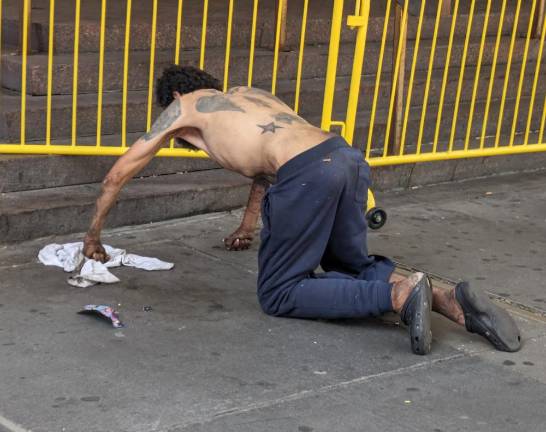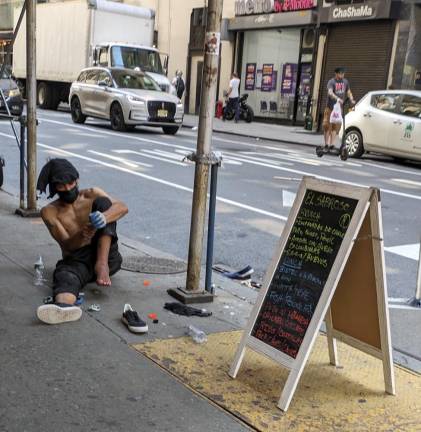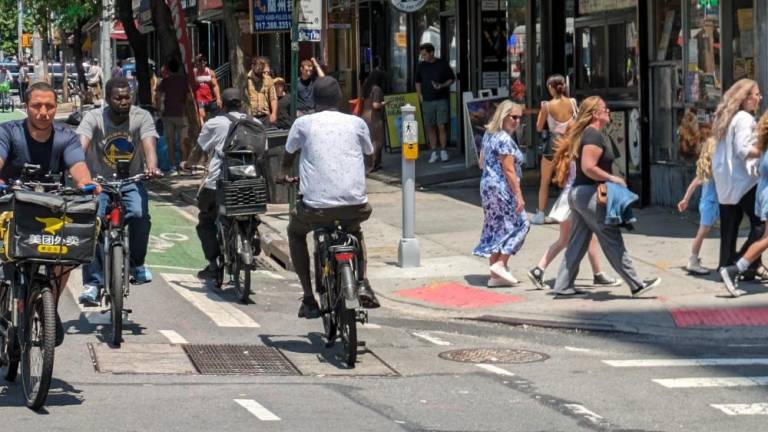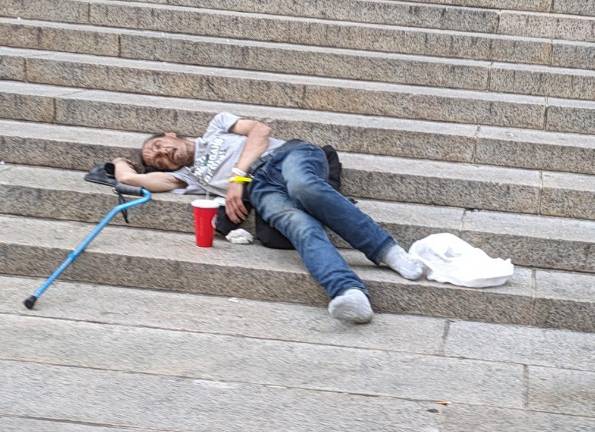“Strip of Despair”: What Does It Mean?
The New York Post recently coined a large section of Midtown a “strip of despair”: an area overrun with menacing street people while an indifferent police force looks away. Our reporter pulled his socks up and his Knicks hat down low in search of enlightenment.




Did you ever wake up and feel not quite like yourself? Call it Kafkaesque if you wish, “The Metamorphosis” come to Midtown, but this is what happened on Monday June 17— a new week, a new me, apparently, for according to the front-page of the New York Post I, whose place of employment is an office on the northwest corner of 8th Avenue and West 35th Street had an alternate address now.
My jovial breakfast joint a few buildings up the block, Essen, had been relocated too, for 8th Avenue had been given the Post-pundemic sobriquet of “8th Blunder,” a corridor of crime stretching 30th Street to at least 45th Street. Observed one area worker who might have a future in headline writing: 8th Avenue today is “a strip of despair.”
“Strip of despair”? Isn’t that a bit dramatic? Sounds more like a line from one of Post restaurant critic Steve Cuozzo’s impassioned steakhouse reviews than sober urban reportage.
Between “Fun City” and “The City of Yes,” what happened that brought us to—I could barely form the words—the “Strip of Despair”?
The Post story averred that one reason for this desperation was the high concentration of drug abuse and other social service organizations in the area.
Surely this is true, in part.
Just outside my office door, there are junkies and other infirmed people sprawled out daily around Penn Station, the Moynihan Train Station, and the steps of the James Farley Post Office.
Had I become calloused to their misery, which registered most often as a vague, rushing regret, not a danger, though it must be said that many women friends have felt differently. Also, weren’t junkies and homeless and a wide range of crazy people more or less always a part of midtown’s permanent scenery?
As someone intimately familiar with 8th Avenue from Times Square to Chelsea, from the mid-1980s onwards—as someone old enough to remember the term “bag ladies” and to have exchanged cold hard American cash for Show World Tokens—I can say with confidence the “strip of despair,” has always been a place of tensions, intensities and contrasts.(A Show World token for your thoughts?)
While this was somewhat less true in the so-called Giuliani-era of “Disneyfication,” when the beloved by some, reviled by others adult theaters, peep shows, bookstores were given their walking papers by the city and big real estate, it was never wholly clean. It couldn’t be, not even when the kung fu movies and arcades vanished too.
The Port Authority bus terminal was still there and for that alone—a direct link to our collectively seedier past—little could faze me. Or so I thought.
I walk fast, so I walked the strip of despair multiple times over multiple days in June during the first great heat wave of summer. I walked both sides of the street in both directions and took various side loops over to 9th and 7th Avenues too.
What I saw didn’t frighten me, only rarely threatened me but it did greatly concern me.
Starting at 32nd Street, the first thing you notice are those contrasts: the marble steps of the Post Office radiant in bright light, tourists milling about and, on one day, a lunchtime demonstration of Falun Dafa, the Buddhist-inspired Chinese exercises one often sees in Seward Park, while... this or that, usually male, often overdressed, unwashed homeless person is prostate or digging through the trash can.
Across the street on the Madison Square Garden side, things are hectic but pretty clean, as befits the corner of 8th Avenue and 33rd Street, co-named Joe Louis Plaza—salute to the Brown Bomber! Also to the cops and private security guards who keep the surrounding plazas trouble free—it’s not an accident, and it’s not easy.
Heading north a small, shadowy sign DVD Lingeries offers faint but comforting remnant of the strip’s raunchier past, while a brazenly illegal, unlicensed “Cannabis Smoke Shop” that appeared to be shut down offered one of numerous reminders just how poorly New York City and state are handled the legalization of marijuana.
Surely a store called “Shaky Eyes Smoke”—as yet not shut down— is 100% legitimate, isn’t it? Said one female commuter who passes through the area on the way to work in Hell’s Kitchen, “too bad people can’t overdose on weed.”
Every time I pass the Port Authority, I pause to pay respects to the Jackie Gleason statue of Ralph Kramden from the classic comedy The Honeymooners—installed in 2000—and by extension, his service, as a bus driver, to all New Yorkers. If it’s arguable which is a greatest black and white, city sitcom, The Honeymooners (1955-56) or Car 54, Where are You? (1960-1962), the character created by Jackie Gleason remains immortal.
Also unkillable, though some individuals expire and are replaced, is the tumultuous and pained perimeter of the Port Authority: 1989, 2024, what’s the difference? My shorts are camouflage now, not Hawaiian, but I still wear a Knicks hat and drug addicts, mendicants and borderline psychos are still in full effect.
There are fewer sexual propositions and the streets—in contradiction to so-called “safe streets” advocates—are far more dangerous than they were 10, 20, 30, 40 years ago.
I can ignore and walk brisky past the wild-eyed vagrant-looking type threatening me, “stop taking f**cking videos, man!”—I wasn’t, and even if I were, how at the corner of 42nd Street and 8th Avenue is that an offense? Discretion being the better part of valour, I ignored the goon and kept walking—only to nearly be run over by a red-light running, speeding delivery bike.
No amount of street smarts and caution could protect me from this person or all of the other lawless miscreants who, it became glaringly obvious, pose a far greater menace to more people than daylight drug addicts and illegal weed shops combined.
Every direction one turns from 42nd Street to 50th, including the once more placid 9th Avenue of Hell’s Kitchen, the scourge of illegal ebike, moped, and scooter anarchy runs rampant, and if you don’t look four times—even when you have the light—they’ll run over you too.
This betrayal of traditional bicyclists and pedestrians by erstwhile “progressives” (sic) is both egregious and unforgivable.
So-called “bike lanes” have become defacto, publicly subsidized autobahns for delivery “app” companies and an army of often illegal vehicle driving delivery desperadoes.
Individually, I can empathize with them. Collectively, they are a greater menace than any addict I saw crawling, sleeping or stumbling on the “Strip of Despair.”